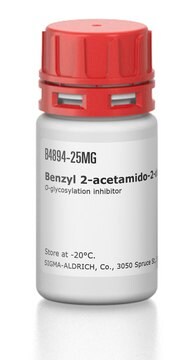SML1620
NGI-1
≥95% (HPLC)
Synonyme(s) :
5-[(Dimethylamino)sulfonyl]-N-(5-methyl-2-thiazolyl)-2-(1-pyrrolidinyl)-benzamide, ML414
Se connecterpour consulter vos tarifs contractuels et ceux de votre entreprise/organisme
About This Item
Formule empirique (notation de Hill):
C17H22N4O3S2
Numéro CAS:
Poids moléculaire :
394.51
Code UNSPSC :
12352200
Nomenclature NACRES :
NA.77
Produits recommandés
Niveau de qualité
Pureté
≥95% (HPLC)
Forme
powder
Couleur
white to beige
Solubilité
DMSO: 5 mg/mL, clear (warmed)
Température de stockage
2-8°C
Actions biochimiques/physiologiques
NGI-1 (ML414) is an inhibitor of Asparagine (N)-linked glycoslysation. NGI-1 inhibits the oligosaccharyltransferase, preventing the attachment to the protein. NGI-1 has been shown to induce senescence in receptor tyrosine kinase dependent tumors.
Code de la classe de stockage
11 - Combustible Solids
Classe de danger pour l'eau (WGK)
WGK 3
Certificats d'analyse (COA)
Recherchez un Certificats d'analyse (COA) en saisissant le numéro de lot du produit. Les numéros de lot figurent sur l'étiquette du produit après les mots "Lot" ou "Batch".
Déjà en possession de ce produit ?
Retrouvez la documentation relative aux produits que vous avez récemment achetés dans la Bibliothèque de documents.
Angelyn Larkin et al.
Biochemistry, 50(21), 4411-4426 (2011-04-22)
Asparagine-linked glycosylation involves the sequential assembly of an oligosaccharide onto a polyisoprenyl donor, followed by the en bloc transfer of the glycan to particular asparagine residues within acceptor proteins. These N-linked glycans play a critical role in a wide variety
Danielle Skropeta
Bioorganic & medicinal chemistry, 17(7), 2645-2653 (2009-03-17)
In a series of investigations, N-glycosylation has proven to be a key determinant of enzyme secretion, activity, binding affinity and substrate specificity, enabling a protein to fine-tune its activity. In the majority of cases elimination of all putative N-glycosylation sites
Cecilia Lopez-Sambrooks et al.
Nature chemical biology, 12(12), 1023-1030 (2016-10-25)
Asparagine (N)-linked glycosylation is a protein modification critical for glycoprotein folding, stability, and cellular localization. To identify small molecules that inhibit new targets in this biosynthetic pathway, we initiated a cell-based high-throughput screen and lead-compound-optimization campaign that delivered a cell-permeable
Ryan A Flynn et al.
Cell, 184(12), 3109-3124 (2021-05-19)
Glycans modify lipids and proteins to mediate inter- and intramolecular interactions across all domains of life. RNA is not thought to be a major target of glycosylation. Here, we challenge this view with evidence that mammals use RNA as a
Notre équipe de scientifiques dispose d'une expérience dans tous les secteurs de la recherche, notamment en sciences de la vie, science des matériaux, synthèse chimique, chromatographie, analyse et dans de nombreux autres domaines..
Contacter notre Service technique







